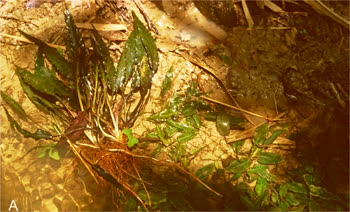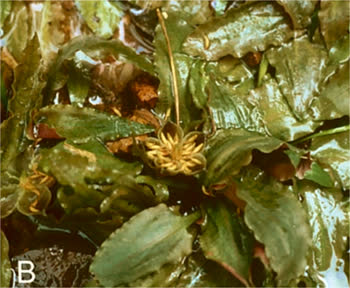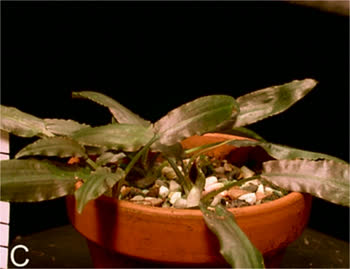Cryptocoryne palawanensis Bastmeijer, N.Jacobsen & Naive, 2022
Naive, Mark Arcebal K., Bastmeijer, Jan D. & Jacobsen, Niels, 2022, On the identity of Cryptocoryne pygmaea (Araceae) from Western Mindanao and the description of a new species from the islands of Palawan and Busuanga, Phytotaxa 572 (3), pp. 295-300 : 298-300
|
publication ID |
https://doi.org/ 10.11646/phytotaxa.572.3.9 |
|
DOI |
https://doi.org/10.5281/zenodo.7328422 |
|
persistent identifier |
https://treatment.plazi.org/id/361A8793-E94C-1D4D-FF3F-FD09FB96FCDD |
|
treatment provided by |
Plazi |
|
scientific name |
Cryptocoryne palawanensis Bastmeijer, N.Jacobsen & Naive |
| status |
sp. nov. |
Treatment
Cryptocoryne palawanensis Bastmeijer, N.Jacobsen & Naive , sp. nov. Fig. 2 FIGURE 2. Cryptocoryne palawanensis. A. Habitat and habit (B 787). B. Fruiting plant showing the opened, starshaped syncarp (B 794). C. Cultivated, flowering plant (B 790). D–F (B 793). D. Spathe showing the oblique opening of the limb. E. Detail of limb surface. F. Close up of the cut open kettle showing the female flowers, olfactory bodies, and male flowers and the flap. Photos by J.D. Bastmeijer. Scale 1 cm.">View FIGURE 2 .
Cryptocoryne palawanensis is somewhat similar to C. pygmaea however, the new species can be recognized by having these following characters: olive green or brownish, more or less shiny purplish striped to marmorated leaves that are ovate to narrowly ovate; the spathe has an obliquely twisted limb with a rough inner surface, without a distinct collar, 1–3 cm long caudate appendage, and the colour of the whole inside is red to dark red.
Type: — PHILIPPINES. Luzon, Palawan, W of Taytay, stream near the Nagbenter River , close to the tidal area, 13 May 1999, Bastmeijer 794 (holotype L!, isotypes PNH!, HNUL!) .
Amphibious herb, submerged specimens up to 25 cm. Rhizome rather stout, stolons long, slender. Cataphylls 2–3 cm long, subulate, whitish to greenish, striate, glabrous, somewhat recurved. Leaves 5–25 cm long, up to more than 10, submerged longest, green to olive green or brownish, more or less purplish striped to marmorated on the upper surface, lower surface green to more or less dark red; petiole 4–15 cm long, longest in continuously submerged specimens; lamina smooth to somewhat undulate at the margin, somewhat shiny, ovate to narrowly ovate, 4–13 cm long and 1–2 cm broad with a rounded to truncate to more or less cordate base, apex acute to obtuse. Peduncle 1–5 cm long. Spathe 3.5–5.0 cm long, the upper part greenish to brownish, smooth to rough with elongate protuberance like structures on the outer surface, the lower part whiteish; kettle ca. 1 cm long, inside white; tube short, usually less than 0.5 cm long, flap whitish; limb 2–4 cm long, inner surface rough, without a distinct collar, more or less upright forward twisted, into a 1–3 cm long caudate appendage; the colour of the whole inside is red to dark red. Spadix ca. 1 cm long. Female flowers 5–7, greenish to whitish, more or less finely purple spotted, with small, rounded stigmas. Olfactory bodies rounded, whitish to yellow. Male flowers 20–30; appendix white. Syncarp more or less broadly ovoid, smooth, seeds brownish, endosperm present, embryo simple, cone shaped, with an undifferentiated plumule. Chromosome number 2 n = 34 (Reported for NJ 2962!, from Busuanga; Arends et al. 1982).
Distribution:— Endemic to the Philippines. The species has been observed in northern Palawan and Busuanga.
Habitat:— Small streams or rivers with slow to rather quickly running water, with a sandy or stony bottom, not high above sea level.
Proposed conservation status:— The distribution of the species is restricted to the islands of Busuanga and Palawan with less than half a dozen known localities (1999). The habitats in which it occurs were already then generally severely degraded and found near human settlements. Following the Red List Criteria of the IUCN Standards and Petitions Subcommittee ( IUCN 2022), we proposed this species to be treated as Near Threatened ‘NT’.
Etymology:— The specific epithet ‘ palawanensis’ was coined after the island of Palawan, Philippines, situated in the western part of the archipelago.
Cultivation: — The first results in cultivation shows that it is an easy grower in mineral soil, and with some leaf peat added. It also proves that it is a good aquarium plant.
Specimen examined:— PHILIPPINES. Bastmeijer 787, 07 May 1999, Busuanga. Near Labangan bridge nr 1; B 788 , 11 May 1999, Palawan. S of Taytay. NW of lake Manguao; B 789 , 12 May 1999, Palawan. S of Taytay. Near Bato bridge; B 790 , 12 May 1999, Palawan. S of Taytay. Near Bato bridge; B 791 , 13 May 1999, Palawan. W of Taytay , near Embarcadero bridge; B 792 , 13 May 1999, Palawan. NW of Taytay. Near Isang bridge nr. 1; B 793 , 13 May 1999, Palawan. NW of Taytay. Near a bridge (under construction); B 794 , 13 May 1999, Palawan. W of Taytay. Near the Nagbenter river ; B 795 , 14 May 1999, Palawan. N of Taytay. Near Sandoval ( B numbers at C!, L!, PNH!, SING!); NJ 2962 , Busuanga , commercial import, 8 October 1975 ( C!); Merrill 9272 ( K!, US!) , Cryptocoryne “ pygmaea ” from Palawan, Tatay, May 1913.
Notes:— For a number of years, Cryptocoryne palawanensis was referred to C. pygmaea and was only known from a few herbarium specimens. It was not until 1999 when new material was obtained ( Bastmeijer & Morco 2000), allowing us to get a good knowledge of the species still assuming that the Palawan samples belonged to C. pygmaea .
Live specimens in cultivation were first known in 1975 when an unknown plant (NJ 2962, C!), in a commercial shipment of C. aponogetifolia from the Philippines, turned up in Copenhagen (Planteimporten). After flowering, the plant was referred to C. “ pygmaea ” (de Wit 1990, Bastmeijer 2018). The unknown origin of this plant was cleared up during Bastmeijer’s trip to visit Herson Morco in 1999 (Morco International Aquatics, Manila, Philippines). It was possible to disclose the former 1975 locality to the island of Busuanga (Calamian group, halfway from Mindoro to Palawan), from where local suppliers had sent plants to Manila where they were shipped to Copenhagen ( Bastmeijer 2018).
In 1984 a botanical expedition to Palawan, sponsored by the Hilleshög Forestry (timber) Company ( Hilleshög, 1985), found C. “ pygmaea ” near Lake Manguao (= Lake Danao) - but no live material was brought back. During Bastmeijer’s and Morco’s trip in 1999, a number of new localities were found in the northern part of Palawan. The specimens growing on the banks were 5–8 cm in height while the ones from deeper water grew up to 25 cm ( Bastmeijer 2018).
The Busuanga plants generally have narrower and more colourful leaves than those from Palawan, and the spathe limb ends in a short tail, while the tail in the Palawan specimens is longer.
C. palawanensis has up to now not been found in mid and southern Palawan.
References
- Arends, J. C., Bastmejer, J. D. & Jacobsen, N. (1982) Chromosome numbers and taxonomy in Cryptocoryne (Araceae). II. Nordic Journal of Botany 2: 453 - 463. https: // doi. org / 10.1111 / j. 1756 - 1051.1982. tb 01208. x
- Bastmeijer, J. D. & Morco, H. (2000) Cryptocoryne pygmaea Merrill (Araceae) von Busuanga und Palawan (Philippinen). Aqua-Planta 25 (3): 99 - 107.
- Bastmeijer, J. D. (2018) The crypts pages. Available from: http: // crypts. home. xs 4 all. nl / Cryptocoryne / index. html (accessed 1 August 2022).
- Hilleshog Forestry, A. B. (1985) The Palawan Botanical Expedition Final Report.
- IUCN Standards and Petitions Subcommittee. (2022) Guidelines for Using the IUCN Red List Categories and Criteria. Version 15.1. Available from: https: // nc. iucnredlist. org / redlist / content / attachment _ files / RedListGuidelines. pdf (accessed 12 August 2022)
- Wit, H. C. D. de. (1990) Aquarienpflanzen, 2. Auflage. Ulmer, Stuttgart.
- A. Habitat and habit (B 787).
- B. Fruiting plant showing the opened, starshaped syncarp (B 794).
- C. Cultivated, flowering plant (B 790). D–F (B 793).
- D. Spathe showing the oblique opening of the limb.
- E. Detail of limb surface.
- F. Close up of the cut open kettle showing the female flowers, olfactory bodies, and male flowers and the flap.
| Copyright 2024 Richard J. Sexton |






